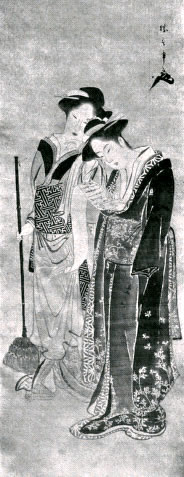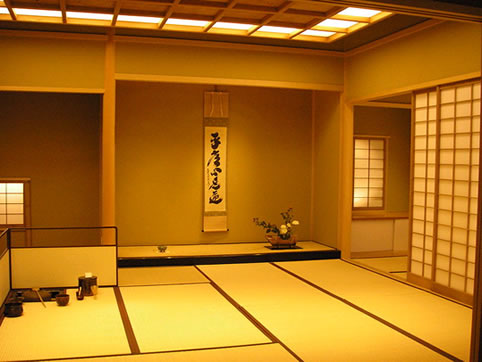The Secularization of Zen Art
 Zen art may easily be made to serve a decorative purpose, and indeed the Zen temples show various examples of dragons so used. Moreover, a Zen landscape may be enjoyed by any man, if not exactly in the spirit in which it was painted, then simply as a picture of nature's beauty. Representations of the saints, hermits and deities may be regarded as mere human figures in interesting, if not weird, postures, and may attract many art lovers, almost apart from the associated stories of attainment in Zen enlightenment. Thus it was only one step from this idealistic art to a romantic art and thence to an art of realistic motive. The landscape of Zen painting became a strong incentive to, and model for, the secular landscape and was further applied to decorative art.
Zen art may easily be made to serve a decorative purpose, and indeed the Zen temples show various examples of dragons so used. Moreover, a Zen landscape may be enjoyed by any man, if not exactly in the spirit in which it was painted, then simply as a picture of nature's beauty. Representations of the saints, hermits and deities may be regarded as mere human figures in interesting, if not weird, postures, and may attract many art lovers, almost apart from the associated stories of attainment in Zen enlightenment. Thus it was only one step from this idealistic art to a romantic art and thence to an art of realistic motive. The landscape of Zen painting became a strong incentive to, and model for, the secular landscape and was further applied to decorative art.
A Travesty on Han-Shan (Kanzan) and Shih-Te (Jittoku) By Katsukawa Shunsho (1726-92) Japanese, Ukiyo-I: School In the Museum of Fine Arts Boston The two poet-hermits are here represented as women: one reading a love-letter instead of the blank scroll peculiar to Han-Shan; the other holding an ordinary indoor broom instead of the besom carried by Shih-Te. Painted in colors on silk and mounted as a kakemono.
These are cases in which secularization of Buddhist art is indeed apparent; but the process was, carried so far by the later genre painters that Fugen came to be represented as a courtesan reading a love-letter and Kwannon as a maid coming from the market with her basket of fish. Such pictures are manifest instances of sacrilege against the Zen ideal (A Travesty on Han-Shan (Kanzan) and Shih-Te (Jittoku) By Katsukawa Shunsho (1726-92) ; but on the other hand there was a more serious secularization which, though worldly in content, nevertheless retained, in composition and brush strokes, the "wind-frame" of Zen painting. In Japan this is first noticeable among works by Kano Masanobu (died 1490) and his son Motonobu (1475-1559), and has been perpetuated by their descendants of the Kano Academy , an idealistic school with strong romantic tendencies.
 The Zenist would say, in self-confidence, that moonlight could, without lessening its purity and brilliance, penetrate everywhere and be reflected even from dust. The pure moonlight of the Zenist enlightenment permeated every corner of social and domestic existence, primarily through tea and its art, what Mr. Okakura has called "Teaism." Tea is believed to be a calming drink, and the Zenists used to take it sitting in a quiet room around a little hearth let into the floor as a convenience for boiling water. This meeting of those who were united in the cult of serenity became a manifestation of the religion of beauty, — the beauty which lies in subdued tone and tranquil mood. The tea-room was, perhaps, tiny, but it was always scrupulously clean and furnished in the simplest way. Similarly the garden, as well as the trees and stones in it, were arranged in accordance with the "air-rhythm" of the mind purified by Zen culture. On one side of the room there was a little alcove, dedicated to the cosmic spirit of simple beauty, wherein a small landscape painting or a calligraphic poem-writing was hung. The smoke of incense rose in the dusk of this space, the incense which never irritated the senses but enabled one to inhale the essence of delicacy and composure. A little gong summoned the guests to this tiny chapel of purity; they proceeded quietly and glided into it; then they drank cups of tea amid surroundings of the utmost calmness. There they would talk only of things outside the world, "wind and moon," "air and stream," or anything else which might help to pacify their minds. The spirit of Zen manifested in Teaism penetrated into the households of nobles and peasants alike. Every Japanese house is built in a style more or less affected by the atmosphere of the tearoom, and in the main rooms are always the alcoves, the shrines of simple beauty. Beside a picture hanging within, there may be an incense pot, a flower vase, a few scrolls; all other furniture is carefully excluded. A family may possess a rich collection of paintings; but only one or a pair, at most a set of three, would be admitted in a room. The house and its chambers should not be used for an exhibition of art works, because real enjoyment of art should be concentrated on a few precious pieces. The garden, its trees and stone lanterns, the pot for washing-water usually standing on a stone alongside the veranda, even the interior of a latrine, in short, everything that is within or around the house, ought to partake of the purity of the chapel and express in its own way the adoration of nature's beauty. Thus the art of Zen was secularized; thus, too, the abodes of man were purified; and throughout we see the Buddhist ideal of communion, no longer made sensible in temples and statues, in ceremonies and rituals, but manifested in the homes of human beings, as a religion of simple beauty, — a cult of nature and of spiritual life.
The Zenist would say, in self-confidence, that moonlight could, without lessening its purity and brilliance, penetrate everywhere and be reflected even from dust. The pure moonlight of the Zenist enlightenment permeated every corner of social and domestic existence, primarily through tea and its art, what Mr. Okakura has called "Teaism." Tea is believed to be a calming drink, and the Zenists used to take it sitting in a quiet room around a little hearth let into the floor as a convenience for boiling water. This meeting of those who were united in the cult of serenity became a manifestation of the religion of beauty, — the beauty which lies in subdued tone and tranquil mood. The tea-room was, perhaps, tiny, but it was always scrupulously clean and furnished in the simplest way. Similarly the garden, as well as the trees and stones in it, were arranged in accordance with the "air-rhythm" of the mind purified by Zen culture. On one side of the room there was a little alcove, dedicated to the cosmic spirit of simple beauty, wherein a small landscape painting or a calligraphic poem-writing was hung. The smoke of incense rose in the dusk of this space, the incense which never irritated the senses but enabled one to inhale the essence of delicacy and composure. A little gong summoned the guests to this tiny chapel of purity; they proceeded quietly and glided into it; then they drank cups of tea amid surroundings of the utmost calmness. There they would talk only of things outside the world, "wind and moon," "air and stream," or anything else which might help to pacify their minds. The spirit of Zen manifested in Teaism penetrated into the households of nobles and peasants alike. Every Japanese house is built in a style more or less affected by the atmosphere of the tearoom, and in the main rooms are always the alcoves, the shrines of simple beauty. Beside a picture hanging within, there may be an incense pot, a flower vase, a few scrolls; all other furniture is carefully excluded. A family may possess a rich collection of paintings; but only one or a pair, at most a set of three, would be admitted in a room. The house and its chambers should not be used for an exhibition of art works, because real enjoyment of art should be concentrated on a few precious pieces. The garden, its trees and stone lanterns, the pot for washing-water usually standing on a stone alongside the veranda, even the interior of a latrine, in short, everything that is within or around the house, ought to partake of the purity of the chapel and express in its own way the adoration of nature's beauty. Thus the art of Zen was secularized; thus, too, the abodes of man were purified; and throughout we see the Buddhist ideal of communion, no longer made sensible in temples and statues, in ceremonies and rituals, but manifested in the homes of human beings, as a religion of simple beauty, — a cult of nature and of spiritual life.

 email
email